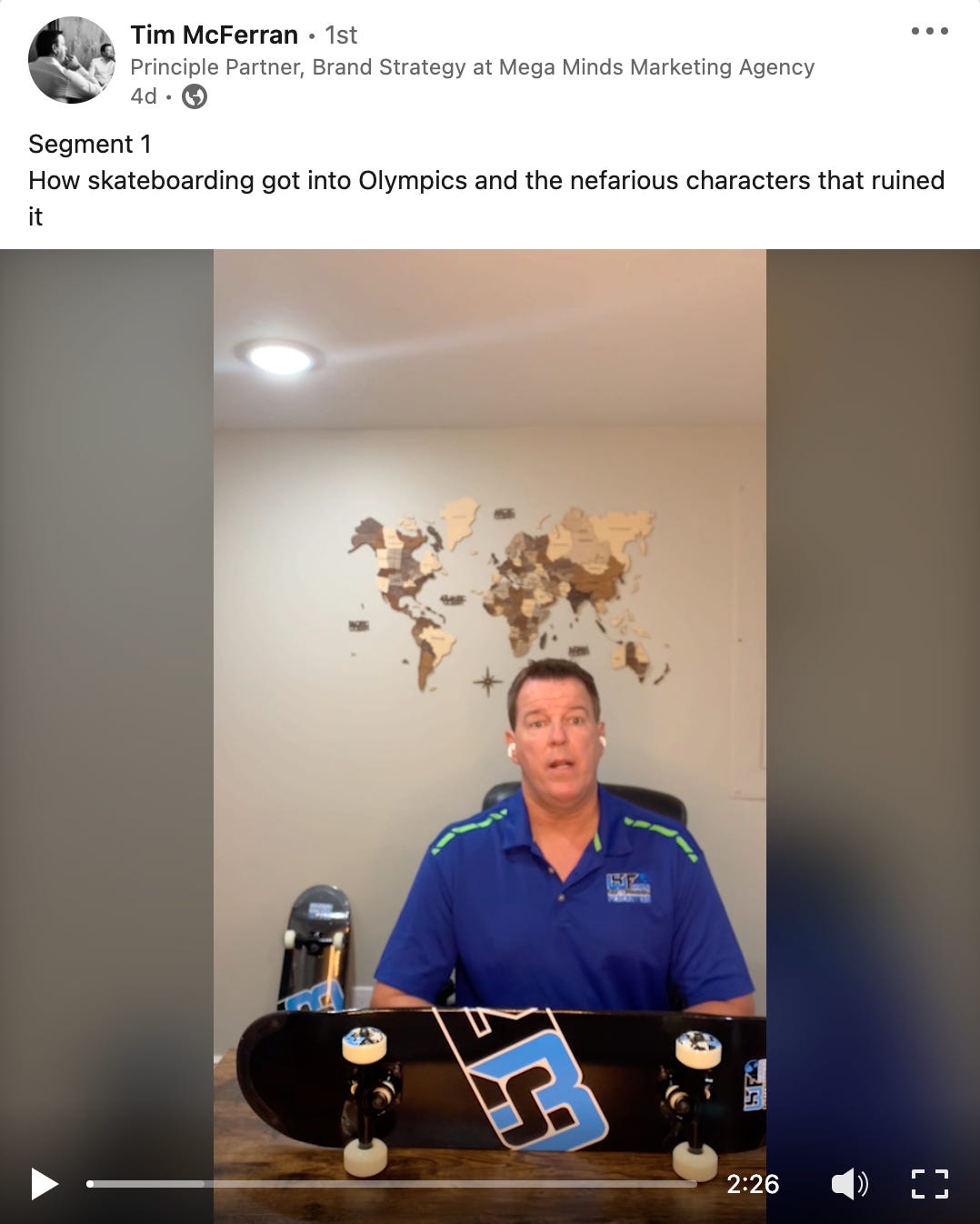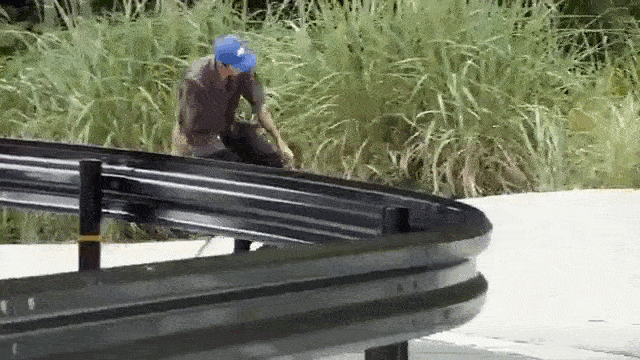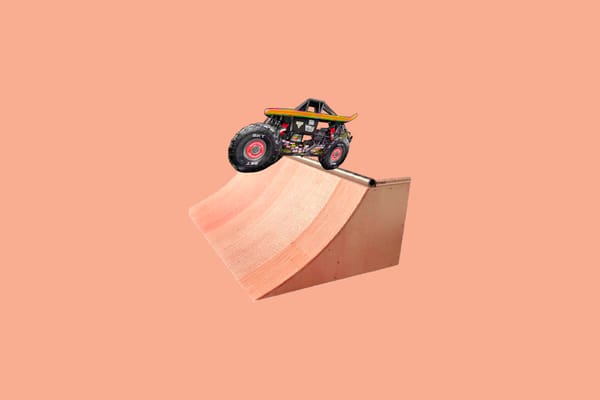Sirakos, help
Plus: Skateboardle, Olympic-level mudslinging, Shin Sanbongi, and more.
The definitive weekly ranking and analysis of all the skateboarding and other online things that I cannot stop consuming and how they make me feel, personally.

Sirakos, help
Rank: 31st St, 20th Ave
Mood: 🤕
Even after a lifetime of expectation never quite squaring with reality, there’s a part of most skateboarders that still think they’ve got something for the spots they see in videos or magazines. No matter how chunked out they look or how many comments online express the degree of difficulty you’re about to encounter, the ego perseveres. So perhaps you flesh out a mental trick list, ranking it from the things you should be able to do with relative ease, to the ones that might take a few minutes, to a few dream maneuvers that don’t seem too far outside possibility’s range.
Then you get to the spot. The ground is rough, the sun presses down mercilessly, and not even those Powell-Peralta Dragon wheels would help you navigate safely over the shards of glass. Suddenly your mental trick list gets pared back to post-it note or postage stamp size. Then, after you’ve struggled for hours to land something, anything, an elderly Greek man named Sirakos might approach to ask how you’re doing. He’ll suggest coming earlier next time, around 7am, to avoid the heat. He might tell a story about his brother who works in sales and how one time he sold a pair of white shoes and a can of black spray paint to a widow looking for black shoes in preparation for her late husband’s funeral—these two sales apparently indicative of his brother’s prowess as a salesperson and not his moral failings as a person.
You’re not sure if the brother exists or if that’s just an old old-man joke, but then Sirakos gives you his business card and tells you he works in real estate and that if you ever need anything, anything at all, to give him a call. You thank him before he daps you up and leaves. But, unfortunately, what you need, Sirakos can’t help you with. And finally, as your water bottle runs out, your legs begin to seize, and your phone is about to die, you admit defeat to a reality you chose to ignore—one which you thought could be tweaked and twisted into your own.

New …ordle just dropped
Rank: 1
Mood: 🧩
Thanks to the good folks at SkateVideoSite, skateboarding has finally realized the level of cultural prevalence and permanence that begets its own daily guessing game with Skateboardle. The rules are simple:
Each day Skateboardle features 6 clips from a single skate video.
Guess the video title in 6 tries or fewer, and be sure to come back every day for a new video.
Tuesday was the first Skateboardle I played, and I was surprised that I couldn’t place the first clip (AVE, switch front crook shove), but Anthony Pappalardo’s nollie frontside flip clue made it clear.
Skateboardle 2022-08-23
🛹 🟥🟩⬛️⬛️⬛️⬛️
It was a personally shameful moment but still fun. And so far, my first few days of Skateboardling have been a treat. It might have even inspired me to rewatch Harsh Euro Barge.

Release the tape (segment 2)
Rank: 2
Mood: 💩📼
Last week, while scrolling through the most accursed and soulless of the social media platforms, LinkedIn, a video appeared unprompted in my feed. I was not “connected” to the poster, nor had any of my “connections” liked or shared the post. It was as if the pieces of myself I’d left scattered across the internet (and had written about multiple times in this very newsletter) had led it directly and specifically to me.
The post, made by a man named Tim McFerran, had an accompanying caption that read, “Segment 1 How skateboarding got into the Olympics and the nefarious characters that ruined it.”

According to his LinkedIn, McFerran is the former vice president of Maloof Skateboarding/Money Cup and current president of World Skateboarding Federation (WSF), not to be confused with World Skate, skateboarding’s official Olympic governing body. Initially, in the years leading up to Tokyo 2020, organizations like World Skate, the International Skateboarding Federation (or ISF, which was headed by recently ousted USA Skateboarding chair Gary Ream), and WSF worked together to help bring skateboarding into the Olympics. However, World Skate and ISF would eventually merge and cut WSF out of the process, which led to a “bitter legal dispute.”
McFerran’s LinkedIn video starts with him describing the goal of WSF.
World Skateboarding Federation was set up many years ago with the purpose of helping individual countries, and the skateboarders within those countries, to organize. To be able to create NGBS, or National Federations. These are non-profit organizations in their own countries so that they can be set up to receive funds from the government to help support skateboarding.
He then makes a strange and, at best, inaccurate claim about how skateboarders outside of the United States earn money to support their Olympic careers.
It’s totally different in the U.S. where the primary skateboarder is sponsored by brands and they’ve got big sponsorships and small sponsorships. But in the U.S., the big brands that sponsor skateboarding are regulated, basically, to the U.S. There are some exceptions, where athletes from different countries have gotten some bigger money, but very, very few. Your average athlete is at a disadvantage unless they live in the U.S. if they ever want to be in the Olympics.
Are all of the podium-finishing Japanese, Brazillian, and Australian athletes from Tokyo 2020 “exceptions?” Whatever the case, McFerran continues, saying all of that was “… not really why I’m here.”
I want to talk about how skateboarding got into the Olympics, I want to talk about salacious things, I want to talk some scandals, and I want to talk about, in my opinion, two complete idiots with a combined IQ of less than 100 that were the mechanisms for more nefarious characters trying to garner more control of skateboarding. Stay tuned.
Now that’s a tease. However, “Segment 1” was posted over a week ago and there hasn’t been any follow-up since. We’ve stayed tuned. Don’t lead us on, Tim. Wade into the murk and the mess. Sling your mud, man.

Way to go, Ted
Rank: C’mon
Mood: 🤮
Ted Wheeler, the mewling mayor of Portland, Oregon, tweeted in celebration of Polar Skateboards rider Emile Laurent turning himself in to police after a felony warrant was issued for his arrest. Charged with “25 counts of criminal mischief and accused of causing around $20,000 in graffiti damages” for allegedly tagging under the handle “TENDO,” Laurent was released pending his first appearance in court on Wednesday.
The PPB even executed a search warrant on 22-year-old Laurent’s home, finding “spray paint cans, heavy markers and various practice pads, paper and other items with the ‘TENDO’ tag,” allegedly linking him to these heinous acts of… graffiti. Wielding the arrest of a young man as a victory for the city vis-a-vis its property owners is a pathetic move for Wheeler but shouldn’t be surprising given how he’s treated other constituents.

Simply reviewed
Rank: 1
Mood: 😌
There’s an adage that gets thrown around, rephrased, and maybe at times a bit skewed when we talk about skateboarding and other relatively subjective things, and that’s “it’s not what you do, it’s how you do it.” An expansion on “style matters,” it speaks to a type of skateboarding that centres primarily on form and execution while perhaps being light on technical ability.

It’s true that not many professional skateboarders could have clips as “simple” as the above in their video parts without facing some level of criticism. However, with Shin Sanbongi, it doesn’t feel like wool over the eyes or a b-side that snuck its way into the Final Cut timeline. The explanation for that is simple: Sanbongi looks really goddamn good riding his skateboarding. It’s the speed in which he moves, the way he appears so in control while tracing the delicate edge of what would be disaster for the rest of us. And then there’s the unique set of intangibles, like the appealing shapes his body makes as he moves through the various stages of a trick, how his pants flow and whip around his legs while he inches closer to maximum velocity, and the environment around him that serves as it’s own character; new intriguing spots that rush past and cause us to play the clip back.
Sanbongi delivers all that and more and is perhaps his strongest offering to date. That effort is appreciated, considering I’d probably still be satiated if all we ever got to witness was Sanbongi going back and forth on an Element flat bar.

Something to consider:
Good things: Learning tricks by watching the older skaters at the spot do them first.
Until next week… read poetry, drink coffee, and hang out with your friends.






